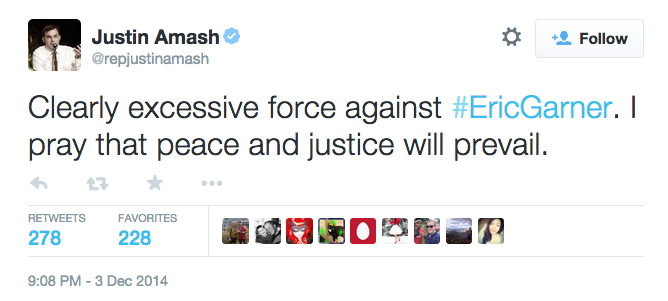Rep. Justin Amash Says Eric Garner Killing Was "Clearly Excessive Force." He's Right.
After a grand jury declined to bring criminal charges against the police officer who placed Eric Garner in a chokehold, leading to his death, Rep. Justin Amash (R-Mich.) had this to say on Twitter:


It's worth hanging on that first word for just a moment—"clearly." It's not just excessive force. It's clearly excessive force. The clarity of what happened to Garner is important.
There's no ambiguity about what happened at the critical moment: Eric Garner, who was arguing with police but not behaving violently or aggressively, briefly pulls his hand away when an officer grabs it from behind. He is then placed in a chokehold grip and slammed to the ground where he is kept in a chokehold as multiple officers pin him down and press his head into the pavement.
Almost as soon as he's on the ground, he begins to gasp, "I can't breathe. I can't breathe." He says it over and over. So far as we know, they were his last words.
At some point, after he is unceremoniously dumped onto a stretcher and put into an ambulance, he dies.
We know all of this because we can see it, clearly, for ourselves. It's all captured on horrific video, available online for everyone to see.
We also know why Garner died. It was not a heart attack, as the officers involved in the incident initially claimed. It was chest compression and "prone positioning during physical restraint by police"—a homicide, according to the coroner.
The police takedown killed him: by placing him in a chokehold, forcing him down, and pinning him to the ground, and continuing to maintain the chokehold grip as Garner gasped for life.

That move—the chokehold that sets up the takedown shown on the video—is prohibited under New York Police Department guidelines, which state that "members of the NYPD will NOT use chokeholds." The guidelines say that the definition of chokehold "shall include, but is not limited to, any pressure to the throat or windpipe which may prevent or hinder breathing to reduce intakes of air."
The manuever was forbidden by the department in 1983, except in cases where an officer's life is in danger, after multiple individuals were asphyxiated while in police custody, according to the New York Daily News. In 1993, it was forbidden entirely.
Finally, we know why the officers were questioning Garner that day. He was believed to be illegally selling loose cigarettes—something he had been convicted of previously. He did not have any on him when he died.
To believe that what happened to Eric Garner is justifiable, here's what you have to be willing to accept: that a group of police officers placed an unarmed man who was not threatening them in a sustained chokehold, a chokehold that led directly to his death, a chokehold move known to have killed people before and which police have been expressly prohibited from using specifically because it had previously led to the deaths of others, over nothing more than the possibility that he might be selling illegal cigarettes on the street.
You don't have to be a crusader, an activist, or someone who is worried about a pattern of aggressive policing to be upset about this case. You just have to watch the video and ask yourself whether you're willing to accept that what it shows was okay.
I don't know what the grand jury saw or heard, or what they were thinking when they reached the conclusion they did. But given the plain evidence, it seems quite clear, as Amash says, that this was excessive force on the part of the police.
Reason is your voice in debates about politics, culture, and ideas. Our annual Webathon is underway and your tax-deductible gift will help us fight against big government, crony capitalism, the drug war, and so much more. For details on giving levels and swag, go here now.
Watch ReasonTV's interview with Rep. Amash below.


Show Comments (186)